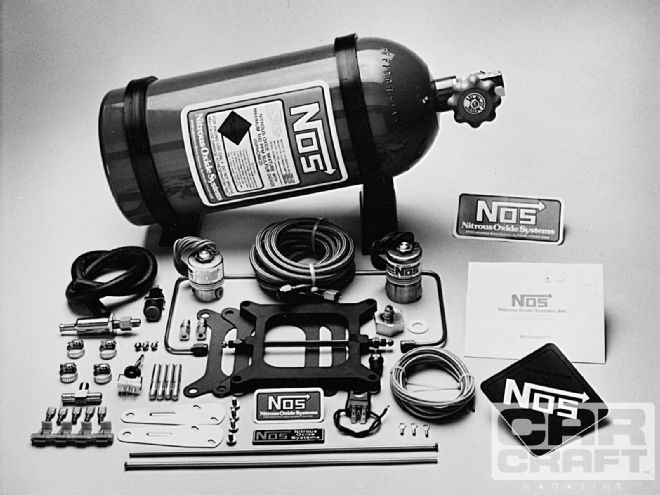
Have you ever wondered what a nitrous system and its "horsepower" jets will really produce on a V-8 engine? We have. Does a nitrous system with "150hp jets" really give an additional 150 hp?
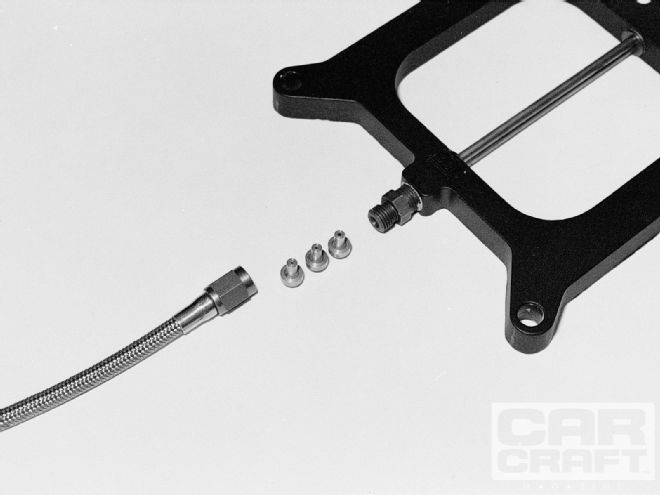 This 1/2-inch-thick nitrous plate is standard issue with both Super Powershot and Cheater systems. A jet (one for nitrous and one for fuel at each end of the plate) installs in between the plate and the line as shown. The 100hp, 125hp, and 150hp jets are standard with the Super Powershot system.
This 1/2-inch-thick nitrous plate is standard issue with both Super Powershot and Cheater systems. A jet (one for nitrous and one for fuel at each end of the plate) installs in between the plate and the line as shown. The 100hp, 125hp, and 150hp jets are standard with the Super Powershot system.
Dale Vaznaian of NOS told us that the approximate power gains with its Super Powershot single-plate system are based on a typical 350-inch V-8 that's been mildly modified. In simple terms, a "150hp" system will produce right around 150 hp on a 350-cube motor. On a smaller engine, the system will likely produce less (as was the case with our 302 Ford). Putting the same 150hp setup on a 450-inch-or-larger big-block may, according to NOS, yield more than 150 hp. How much depends on the engine itself, tuning, and other factors.
Using Westech's dyno we tested a set of "100hp" jets that come with NOS's Super Powershot nitrous system and then the 150hp- and 180hp-rated jets that come with NOS's Cheater System. The Cheater and Super Powershot kits are basically the same,except for the Cheater's larger-capacity solenoids. On any street car, the need for Cheater solenoids is debatable since Vaznaian told us that there are cars on the strip running in the 8s using the smaller Super Powershot solenoids. The only reason we used them was so we could run the big 180hp jets on our screamer 302-a step beyond what the Super Powershot system comes with; its largest are 150hp jets. With an engine on the smaller side, like our test mule 302 Ford, the 100hp, 150hp, and 180hp approximations were not achieved.
With a 350-inch motor we might've made those numbers. We probably would've also gone beyond the rated horsepower had the engine been a big-block, but the nitrous still worked flawlessly during our test. In the end, this 302 Henry was kicking ass and taking names to the tune of 500 hp and a stout 510 lb-ft of torque with the 180hp jets. Check out the dyno charts and sidebars for all the details.
Power Gains and Suggested Tuning Combos With Cheater System
According to NOS, these tuning suggestions and power gains were achieved with a Cheater system and a 450-500ci big-block V-8.
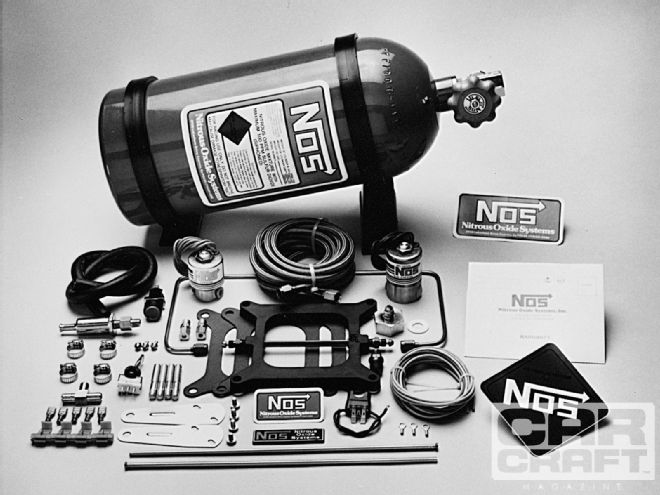 The standard Super Powershot system comes with three sets of jets. PN 5101 is for Holley carbs and PN 5104 is for Q-jets. The Cheater system is basically the same, except for its larger solenoids. Several Cheater variations are available for Holleys, Holley Dominators, Q-jets, and others.
The standard Super Powershot system comes with three sets of jets. PN 5101 is for Holley carbs and PN 5104 is for Q-jets. The Cheater system is basically the same, except for its larger solenoids. Several Cheater variations are available for Holleys, Holley Dominators, Q-jets, and others.
HP Level Jetting N20/Fuel Fuel Quality Ignition Timing Spark Plug Heat Range 150 63/71 92-octane pump gas with 2 degrees Decrease heat octane booster or 100-octane ignition range 1 to 2 race fuel retard steps 180 73/82 105-octane race fuel 4 degrees Decrease heat ignition range 2 to 3 retard steps 210 82/91 110-octane race fuel 6 degrees Decrease heat ignition range 3 to 4 retard steps 250 93/102 110-octane race fuel 8 degrees Decrease heat ignition range 3 to 4 retard steps
The Guinea Pig
This Ford 302 has some bulletproof goods so it'll live through the rigors of being one of NOS's nitrous test mules. Starting with an SVO, 8.2-inch-deck (standard 302) A4 block (basically a 1,000hp piece), the motor has a forged-steel '69-'70 vintage Boss 302 crank with Crower rods in a stock 5.09-inch 302 length. Compression is about 9.5:1 with forged pistons and is achieved with a pair of SVO J302 aluminum heads (PN M-6049-J302)-basically GT40 heads from before they were labeled as such.
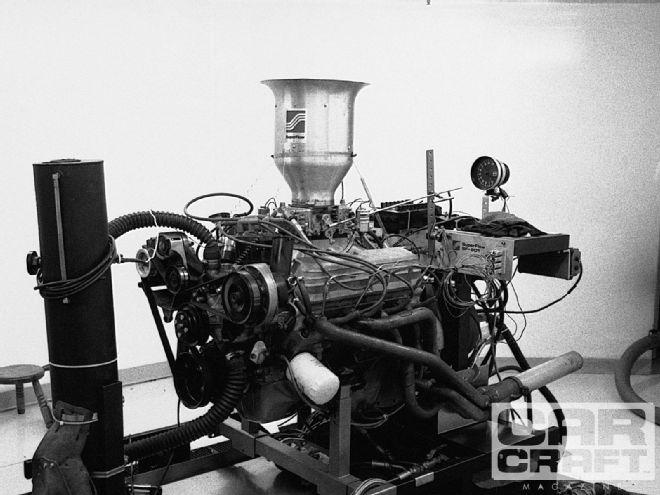
The 1.94/1.60 valves are moved with a Crower solid-lifter roller cam (PN E3903) with 0.546-inch lift on both sides with 270/280 degrees of advertised duration. At 0.050-inch tappet lift, duration is 238/244 degrees. These numbers are with standard 1.6:1 ratio rockers. The lobe separation angle is 112 degrees and the intake lobe centerline is 108 degrees. On top was an Edelbrock Victor Jr. intake and a Holley 750-cfm carb. An MSD billet distributor (PN 8582) and 6AL box provided spark and the motor ran on the dyno through Hedman 1 5/8-inch full-length headers for late-model Mustang 5.0s. A pair of 3-inch collectors about 2 feet in length were attached to the headers. Without nitrous, peak power was 357 hp at 6,000 and 328 lb-ft at 5,100.
Test 1: Baseline
The baseline test was performed with the nitrous system already installed on the engine. That means the plate was serving as a carb spacer-possibly worth a few horsepower at the top end of the scale. This motor was obviously no slouch, even without squeeze. Its peak numbers were 357.6 hp at 6,000 rpm and 328.2 lb-ft of torque at 5,100 rpm-the perfect candidate for lots of juice. Total ignition timing for the baseline was 36 degrees total advance, all in by 3,500 rpm.
RPM Power Torque 3000 156.5 273.9 3100 160.9 272.7 3200 169.6 278.3 3300 176.3 280.6 3400 183.1 282.9 3500 191.6 287.5 3600 201.2 293.5 3700 210.9 299.4 3800 222.5 307.5 3900 226.2 304.7 4000 238.2 312.7 4100 239.8 307.2 4200 251.8 314.9 4300 259.1 316.5 4400 265.8 317.3 4500 273.2 318.9 4600 280.0 319.7 4700 287.2 321.0 4800 296.4 324.4 4900 298.9 320.3 5000 309.1 324.7 5100 318.7 328.2 5200 321.0 324.2 5300 327.2 324.3 5400 336.7 327.4 5500 340.2 324.9 5600 339.4 318.3 5700 340.0 313.2 5800 346.0 313.3 5900 349.0 310.7 6000 357.6 313.0 6100 353.9 304.7 6200 355.2 300.9 6300 349.6 291.4 6400 353.0 289.7 6500 353.3 285.5 6600 346.5 275.7
Test 2: 100HP Jets
On our first nitrous test with the 100hp jets (a size 47 for nitrous and a 53 for fuel), we left the timing at 36 degrees total advance. Reducing it to 32 degrees total helped some, picking up about 5 hp. Yet, the best pull (shown) was with the ignition timing reduced to 30 degrees total. We picked up an additional 8 hp and 11 lb-ft of torque compared to the pull with the engine at 36 degrees total. Compared to the baseline without nitrous, the 47/53 jets netted an additional 72.2 hp and an impressive 102.0 lb-ft more torque-we're talking 429.8 hp at 6,400 rpm and 430.2 lb-ft of torque at 3,900 rpm. For the first two jet tests, the nitrous was switched on at about 4,000 rpm and shut off at 6,500 rpm. For the final step with the 180hp jets, we hit the squeeze at 4,500 rpm and shut off at 6,500 rpm.
Engine Power Torque 3000 150.9 264.1 3100 156.5 265.2 3200 166.1 272.6 3300 220.9 282.6 3400 190.8 294.7 3500 194.7 292.2 3600 200.3 292.2 3700 213.4 302.9 3800 234.4 324.0 3900 319.4 430.2 4000 325.0 426.7 4100 333.7 427.4 4200 337.8 422.4 4300 344.6 421.0 4400 351.9 420.1 4500 359.7 419.8 4600 363.1 414.6 4700 372.5 416.3 4800 377.9 413.5 4900 385.4 413.1 5000 389.5 409.1 5100 395.6 407.4 5200 402.2 406.2 5300 407.5 403.8 5400 414.4 403.0 5500 415.5 396.8 5600 415.9 390.1 5700 421.9 388.7 5800 424.1 384.0 5900 426.1 379.3 6000 424.9 372.0 6100 426.7 367.4 6200 424.8 359.9 6300 420.7 350.7 6400 429.8 352.7 6500 345.0 278.8
Test 3: 150HP Jets
We stepped up to the 150hp jets, 63 for nitrous and 71 for fuel with the Cheater solenoids-with the smaller Super Powershot solenoids, the 150hp jets are larger 73/82 sizes and left the timing at 30 degrees total. Backing off to 27 degrees on a subsequent pull resulted in only a minor power loss-4 hp and 2 lb-ft of torque. For this and the final step we also augmented the 92-octane pump gas with VP 112-octane racing fuel. The mixture was about 60/40, with 60 percent being the race gas. Peak numbers were 466.6 hp at 6,000 rpm and 484.5 lb-ft of torque at 3,900 rpm. So, the 150hp jets gave us 109 hp and 156.3 lb-ft on top of our baseline. These torque numbers are awesome!
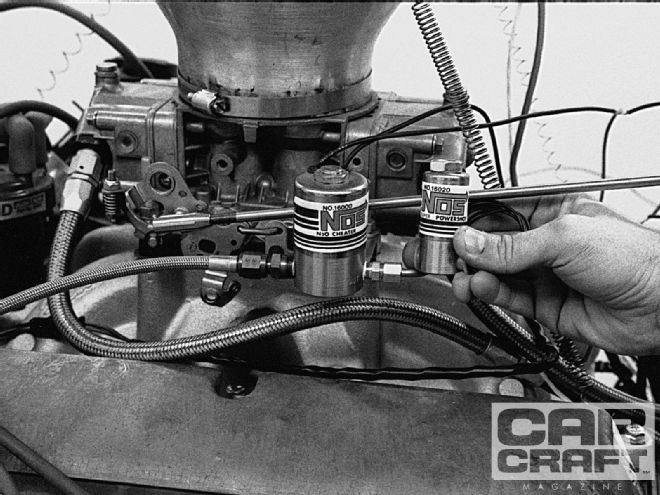 The size difference between the Super Powershot and the Cheater (left) solenoids is apparent. The Super Powershot nitrous and fuel solenoids are good for up to 200 hp-the nitrous solenoid draws 8.6 amps, while the fuel solenoid just 0.6 amps. They have 1/8-inch NPT inlet and outlet threads at both ends. The Cheater solenoids will flow up to 250 hp-the nitrous and fuel solenoids draw 10 amps and 1.6 amps, respectively. The Cheater fuel solenoid also has 1/8-inch threads at both ends, and the Cheater nitrous solenoid has 1/4-inch inlet and 1/8-inch outlet threads.
The size difference between the Super Powershot and the Cheater (left) solenoids is apparent. The Super Powershot nitrous and fuel solenoids are good for up to 200 hp-the nitrous solenoid draws 8.6 amps, while the fuel solenoid just 0.6 amps. They have 1/8-inch NPT inlet and outlet threads at both ends. The Cheater solenoids will flow up to 250 hp-the nitrous and fuel solenoids draw 10 amps and 1.6 amps, respectively. The Cheater fuel solenoid also has 1/8-inch threads at both ends, and the Cheater nitrous solenoid has 1/4-inch inlet and 1/8-inch outlet threads.
RPM Power Torque 3000 152.9 267.7 3100 166.6 282.2 3200 172.0 282.2 3300 205.8 327.5 3400 224.0 346.0 3500 249.7 374.7 3600 279.5 407.8 3700 340.8 483.7 3800 346.5 478.9 3900 359.8 484.5 4000 366.2 480.8 4100 374.9 480.3 4200 381.9 477.5 4300 388.1 474.0 4400 396.7 473.6 4500 404.3 471.8 4600 407.9 465.7 4700 413.5 462.0 4800 420.8 460.5 4900 428.7 459.5 5000 439.9 462.1 5100 444.4 457.6 5200 448.3 452.8 5300 452.7 448.6 5400 456.2 443.7 5500 459.4 438.7 5600 460.8 432.2 5700 460.8 424.6 5800 461.6 418.0 5900 461.7 411.0 6000 466.6 408.5 6100 457.9 394.3 6200 458.5 388.4 6300 457.7 381.6 6400 466.0 382.4 6500 340.7 275.3 6600 334.5 266.2
Test 4: 180HP Jets
With race gas and the timing advance set at 27 degrees total, we were looking for big numbers with the 180hp jets (a 73 size for nitrous and an 82 for fuel). We knew we wouldn't see a 180hp jump over baseline with the 302, but we were still impressed. On the first couple of pulls we instantly saw 495-498 hp at around six grand. We experimented with timing and backed off to 25 degrees total and saw our biggest torque number: a stout 518.8 lb-ft at 4,700 rpm. However, we were chompin' at the bit-we wanted to see 500 ponies. With the timing back at 27 degrees total, we weren't denied on the final pull shown here. The torque peak on this pull was right up there with 510.6 lb-ft at 4,600 rpm. We broke the 500hp threshold at 5,900 rpm with 500.3. Doing the math with the baseline looks like this: The 180hp jets gave us 142.7 hp and a stellar 182.4 lb-ft. Since we were squeezing pretty hard at this point, Vaznaian played it safe with the 73/82 jets, began the pulls at 4,000 rpm, and hit the squeeze at 4,500 rpm. The motor survived the day (about 15 pulls) and will soon be going in a '66 Mustang.
RPM Power Torque 4000 226.8 297.8 4100 233.5 299.2 4200 239.3 299.2 4300 256.6 313.4 4400 287.3 342.9 4500 293.8 342.9 4600 447.2 510.6 4700 452.3 505.4 4800 458.1 501.3 4900 469.4 503.2 5000 475.4 499.4 5100 479.8 494.1 5200 484.4 489.3 5300 487.9 483.5 5400 497.9 484.2 5500 495.7 473.4 5600 496.7 465.8 5700 492.6 453.9 5800 494.3 447.6 5900 500.3 445.4 6000 495.5 433.7 6100 493.8 425.1 6200 494.3 418.7 6300 496.0 413.5 6400 499.3 409.8 6500 494.8 399.8 6600 304.1 242.0